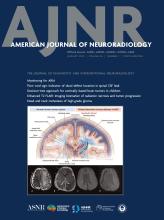This article requires a subscription to view the full text. If you have a subscription you may use the login form below to view the article. Access to this article can also be purchased.
Abstract
BACKGROUND AND PURPOSE: Assessing the treatment success of intracranial aneurysms treated with Woven EndoBridge (WEB) devices using MRI is important in follow-up imaging. Depicting both the device configuration as well as reperfusion is challenging due to susceptibility artifacts. We evaluated the usefulness of the contrast-enhanced 3D ultrashort TE (UTE) sequence in this setting.
MATERIALS AND METHODS: In this prospective study, 12 patients (9 women) with 15 treated aneurysms were included. These 12 patients underwent 18 MRI examinations. Follow-up UTE-MRI controls were performed on the same 3T scanner. We compared the visualization of device configuration, artifact-related virtual stenosis of the parent vessel, and the WEB occlusion scale in 3D isotropic UTE-MRI postcontrast with standard TOF-MRA with contrast-enhancement (CE) and without IV contrast as well as DSA. Two interventional neuroradiologists rated the images separately and in consensus.
RESULTS: Visualization of the WEB device position and configuration was rated superior or highly superior using the UTE sequence in 17/18 MRIs compared with TOF-MRA. Artifact-related virtual stenosis of the parent vessel was significantly lower in UTE-MRI compared with TOF and CE-TOF. Reperfusion was visible in 8/18 controls on DSA. TOF was able to grade reperfusion correctly in 16 cases; CE-TOF, in 16 cases; and UTE, in 17 cases.
CONCLUSIONS: Contrast-enhanced UTE is a novel MRI sequence that shows benefit compared with the standard sequences in noninvasive and radiation-free follow-up imaging of intracranial aneurysms treated using the WEB device.
ABBREVIATIONS:
- AcomA
- anterior communicating artery
- BA
- basilar artery
- CE
- contrast enhancement
- CEA
- contrast-enhanced angiography
- PcomA
- posterior communicating artery
- UTE
- ultrashort TE
- © 2025 by American Journal of Neuroradiology












